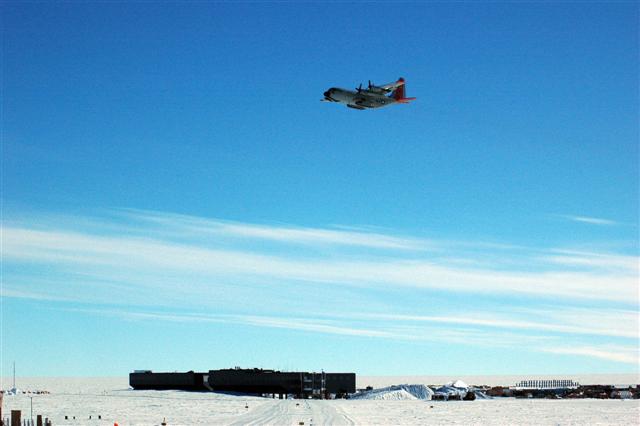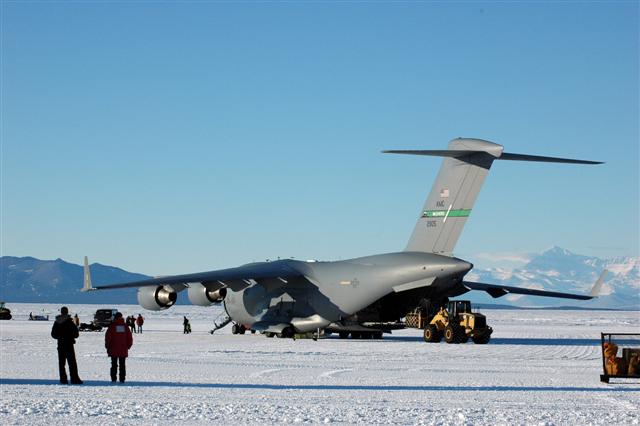|
Open seasonWinter flights scheduled to begin Aug. 20 as McMurdo prepares for summer fieldworkPosted August 17, 2012
The first flights to McMurdo Station Winfly, for winter fly-in, involves six missions carried out by the U.S. Air Force The last flight will be on Aug. 28, and all of the missions will use night-vision goggles (NVG) for landing, a capability the Air Force established several years ago and retests each winter. Last year, a C-17 crew conducted an airdrop flight using NVG at the South Pole Station during Winfly to deliver medical supplies. [See previous articles — Night vision: Air Force successfully tests new capability to fly any time of year to McMurdo and Winter airdrop: Air Forces delivers needed supplies to South Pole using night-vision goggles.] Winfly is a standard part of the USAP operation, though this year promises to be a break with the past in many ways as the National Science Foundation (NSF) The report is expected to serve as a springboard to improve the program’s logistics operation and infrastructure, particularly at McMurdo Station, which was founded in the 1950s for the International Geophysical Year In fact, the project may serve as a paradigm shift in how the USAP normally operates. Currently, the first flight of the summer field season to McMurdo is scheduled for Oct. 1, with the last set to depart Feb. 28. But thanks to the Air Force’s NVG capabilities, such flight deadlines may go away in the future, according to BK Grant, deputy program director for Lockheed Martin Antarctic Support Contract, the civilian company hired by NSF to run the day-to-day operations of the program. “We’d like to look at what a logical breakpoint in the work is,” she explained. “We can be more efficient with fewer restraints on planning, especially with the recommendations coming out from the Blue Ribbon Panel for some major infrastructure improvements. I think we’re going to look at how we can best utilize the time when we don’t have a large science population.” That time generally comes during the Antarctic winter, which runs from March through September, with a caretaker crew at McMurdo numbering around 150. In the summer, several hundred scientists from the United States and around the world travel to McMurdo, which serves as the gateway to field sites as close as a helicopter ride away to others more than a thousand miles across the continent. McMurdo is also the jumping off point for the South Pole Station 
Photo Credit: Peter Rejcek/Antarctic Photo Library
An LC-130 flies over South Pole Station, where a reduced population will require fewer support flights this season.
Operations at the South Pole are also expected to change with the times beginning this year, as the average summer population drops from about 250 to a maximum of 168 people. The new research facility, which was dedicated in January 2008, was designed for 150 people. The additional personnel have been housed mainly in a place dubbed Summer Camp, a collection of heated tent buildings called Jamesways. Meanwhile, in McMurdo, one of the major projects this year will be construction of an additional two-million-gallon fuel tank, which will give the research station the needed capacity to operate for two years without being resupplied by ship. In recent years, resupply missions by vessel have been challenging for various reasons, from the lack of icebreaker support to cut a channel in the sea ice to McMurdo to uncooperative winter weather needed to build an ice pier. [See previous article — Without pier: Floating dock from McMurdo Station found locked in sea ice.] In fact, another mild winter, combined with early storms that repeatedly drove the sea ice out of McMurdo Sound, has again threatened to leave the station without a reliable ice pier. Last year, the U.S. Army Grant said that she expects a major facility assessment to take place this season at McMurdo, along with the development of a master plan that will direct capital improvement projects in the coming years, one of the key recommendations of the Blue Ribbon Panel. “That’s going to start driving more of what we’re doing. Pretty much everything is going to be focused on meeting those objectives,” Grant said. “People will see a lot of changes.” |



For USAP Participants |
For The Public |
For Researchers and EducatorsContact UsU.S. National Science FoundationOffice of Polar Programs Geosciences Directorate 2415 Eisenhower Avenue, Suite W7100 Alexandria, VA 22314 Sign up for the NSF Office of Polar Programs newsletter and events. Feedback Form |



